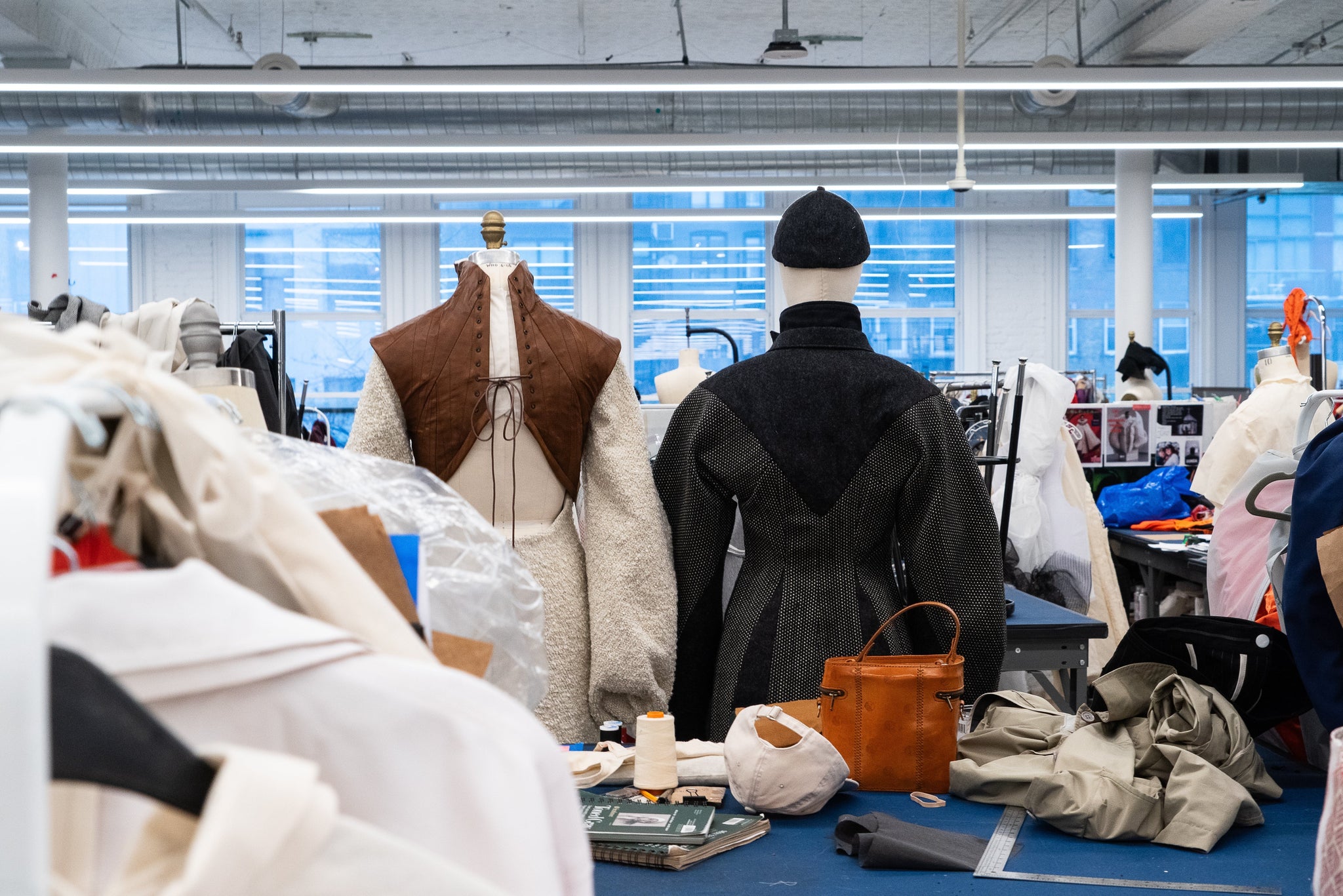Dress as the Border Between Self and Society: An Exploration of Duality

As part of the MFA FDS at Parsons Studio 1 Fall 2025
The concept of dress as a border between the self and society embodies an expression of duality. This duality resonates deeply with my personal experience and heritage. Born to French Canadian and First Nation parents and raised in an Anglophone province, I have always navigated the tension between being proud of my identity and striving to fit in. This internal conflict even led me to work hard to erase my French accent when speaking English. In this collection, I seek to pay homage to my previous work while reflecting on what initially brought me to New York.


Photo Credit : Jessica Nepton-Chayer
Copper Cherry Bags: A Foundation of Materiality
The title "Copper Cherry Bags" emerged from my dual passions for bag-making and furniture design. Copper rivets and cherry wood—integral materials in furniture—symbolize this connection. The bags themselves, made from waxed canvas and leather, echo my heritage: the waxed canvas represents the sails of the ships that brought my French ancestors, and the leather reflects the traditions of my Indigenous lineage. This interplay of materials is possibly a reflection on my inability to choose between two worlds and trying to find harmony in their coexistence.
This ethos carries into my mini-collection, where I incorporate bouclé, wool, and leather. These materials symbolize upholstery, settler material culture, and Indigenous heritage, respectively. They weave together narratives of identity, history, and craftsmanship.
Dress Theory and Indigenous Perspectives
The concept of dress as a border between self and society is further explored in Indigenous Dress Theory and "Dress in Canadian Residential Schools" by Shawkay Ottmann. Within Indigenous communities, dress has historically served as both a means of resisting assimilation and a tool of oppression. For instance, clothing was used in residential schools to separate children from their parents, enforcing a Western worldview. This duality—dress as both a shield and a weapon—informs my exploration of identity and perception. Clothing conceals and protects, yet it also reveals and provokes. It is discomforting and comforting, functional and ideological.
Early Semester Research
In the initial stages of this studio class, I focused on the relational self, situated knowledge, and decentered perspectives. Annemarie Mol’s "I Eat an Apple: On Theorizing Subjectivities" provided a framework for examining subjectivities, which I applied to my practice. My exploration of the city heightened feelings of displacement, and my study of historical patterns informed the modern workwear-inspired designs in this collection, such as a reimagined Sorel coat.
Look 1: Haute Couture as a Barrier
Look 1 features a half-face cowl leather corset paired with a bouclé dress with voluminous sleeves. This ensemble represents the literal and metaphorical barrier between self and society. The corset’s cowl, covering the face, is at once binding and empowering. While it restricts outward expression, it emphasizes inward perception. The wearer controls their narrative, choosing what to reveal. The corset’s textures and ribbing mimic wood bark, evoking my connection to the land, while the boucle fabric references upholstery and my background in furniture design but also brings contrast in texture against the leather corset. The dress’s selvage edges on the cuffs and skirt vent pay homage to the live edges used in furniture, grounding the piece in craftsmanship and naturalism.



Photo Credit : Jessica Nepton-Chayer (Top left & bottom)Carolin Habermann (Top Right)

Look 2: Historical Workwear Reimagined
Look 2 draws inspiration from the Sorel coat and the historical elements of modern workwear, I researched the action-back, underarm gusset, and velvet collar in particular. These features, rooted in durability and longevity, reflect centuries of accumulated knowledge and tradition. My design reinterprets these details, incorporating a more feminine silhouette reminiscent of 1880-90s day coats and the sloped wide shoulders of the 1830s. Playing with the theme of duality, I added a double lapel with a connecting neck guard. This element mirrors the cowl of Look 1, symbolizing protection and shielding.
The coat’s upholstery fabric base, again, nods to my past in furniture design, while 3D-printed gold and silver buttons modernize the piece with their organic shapes. Wide-leg trousers with deconstructed darts (similar to the Look 1 dress) complement the coat, creating a cohesive look.





Photo Credit : Jessica Nepton-Chayer
The Ripple Bag: Movement and Materiality
No look is complete without a bag. The Ripple Bag represents the culmination of my skills and design philosophy. The bag is fully handsewn and crafted from 4-5 oz black vegetable-tanned leather, featuring two inset gussets that provide structure to its organic ripples, thereby evoking a sense of movement. It’s 3D-printed chain links, covered in soft leather, add a tactile, modern element. The bag captures the interplay of tradition and innovation, further emphasizing the duality central to this collection.


Photo Credit : Carolin Habermann
Conclusion and Takeaways
This collection embodies the idea of dress as a border between self and society, drawing on personal heritage, historical references, and theoretical frameworks. Through the interplay of materials, silhouettes, and textures, I seek to explore the dualities that define identity and perception. Each piece—from the corset and boucle dress to the reimagined workwear coat and Ripple Bag—represents a dialogue between the past and the present, the self and the world.

